 CIRCULAR
TIMES
CIRCULAR
TIMESEgyptian Mummy Africa Egypt Sphinx A 1902 Egyptian Mummy and Egyptian, Women - C. Stratz Sphinx is missing part of its upper skull and is proportioned to Upper Egyptian Female.
An International Networking Educational Institute
Intellectual, Scientific and Philosophical Studies
CIRCULAR TIMES HOMEPAGE CONTACT SITE NAVIGATION HIGHLIGHTED TABLE OF CONTENTS
A 1902 Study of Female Egyptian Mummy and Women
Original Photographs
and diagrams of Egyptian mummy and females
from C. Stratz's private collection
Is the Great Sphinx Missing Part of Its Head?
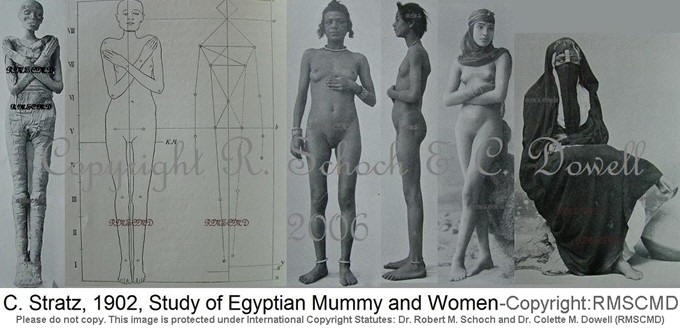
NOTE: The original comparative studies on anatomical features are credited to Dr. C. Stratz, a German physician and physical anthropologist, between a female Egyptian mummy to live (living) women from Egypt over a century ago. Robert grouped them together to make this picture composite from Stratz's images and sent me it online with a note about the ladies - see note below. Colette Dowell
Schoch: The woman in the middle is from Upper Egypt, to the south, so more “African,” than the woman on the far right who appears to be a true Arab so to speak. I am not sure if the woman in clothing is the same woman who is unclothed next to her.
NEXT - I started looking at the ladies and their features and I thought of the Sphinx!
Colette Dowell: Notice the facial features on the Upper Egyptian woman; they are very similar in structure to the facial characteristics of the Egyptian mummy. The “Arabian” woman’s face is square and rectangular in comparison to that of the Upper Egyptian woman.
CD: Modern day Egyptians are a blend of races; it is rare to come across an Egyptian with pure “African” Egyptian genes. The Egyptian faces you see in modern times are not the same as those only a century ago. There are however sects of Egyptians that are still somewhat “pure” in their blood line; usually stemming from Upper Egypt not that of Lower Egypt.
CD: It is hard to determine the original face of the Great Sphinx located on the Giza Plateau through the millenniums of weathering, destruction, refurbishment, alterations and "face lifts." As the Great Sphinx stands today with her modern profile, she is still well within the anatomical class of distinction of the Upper Egyptians, " African," as opposed to the Arabic type features associated with some Egyptian females. Colette Dowell
CD: Look at the graphic I made below . I asked Robert if he had a picture of the Sphinx looking straight on - he did. I took it and placed it next to the lady, and then made the graphic. Look how similar they are to each other in their features. Please read the paper below I wrote as I did some superimposing of the images and I found that the Sphinx's face is identical in proportions to the UPPER EGYPTIAN female face, NOT THE LOWER EGYPTIAN female face........except the Sphinx's face is missing its skull starting at the hairline. WHY? - Colette
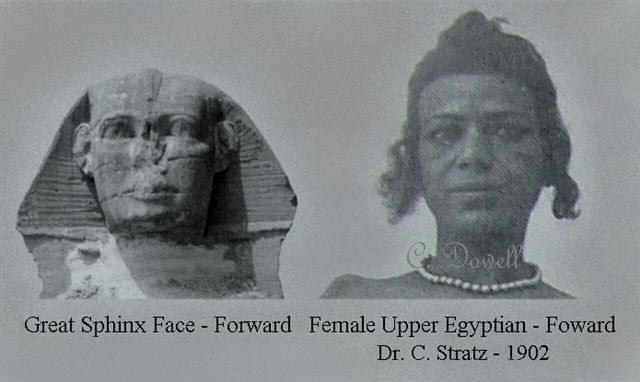
Photograph of Sphinx: RMS Graphic of
Sphinx and Upper Egyptian made by Colette Dowell
Strange Coincidences and
Wanderings of the Mind:
Is the Great Sphinx Missing Part of Its Head?
By Dr. Colette M. Dowell
© May 21, 2006
Original photographs and graphics by
Dr. C. Stratz, Dr. Colette M. Dowell
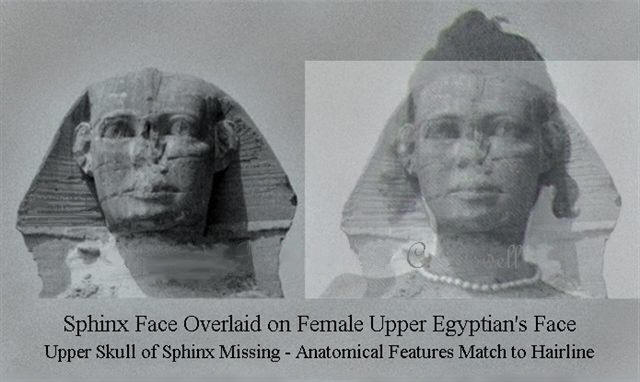
Photograph of Sphinx: RMS - Photograph of Upper Egyptian Female: Stratz -
Graphic of both created by Colette Dowell
I asked Robert (Dr. Schoch) if he had any straightforward shots of the Sphinx’s face because I was interested in comparing the proportions of the Sphinx’s face with that of the female Upper Egyptian’s. He sent me this photo he had taken back in the mid 1990s off a balcony of a hotel that he says does not probably exist anymore, but the height of the balcony brought him almost up to the elevation of the face so he was able to take this straightforward shot as well as he could. I then took the photograph from Dr. C. Stratz of the female Upper Egyptian’s face and placed it next to Robert’s photograph of the Sphinx’s face so I could compare the anatomical proportions between the two. Eerily it looked as if the Sphinx’s face was sculpted and stylized from this female Upper Egyptian. I made a transparency of Robert’s photograph and out of curiosity overlaid it on Stratz’s photograph of the woman. You can see the Sphinx overlays almost perfectly over her face, minus the hairline, where the Sphinx’s skull or face is basically horizontally shaved off and the headdress begins. This is very interesting as the face of the Sphinx if it were to represent a human’s face, is missing the upper skull portion of its head. In all other aspects the proportions of the face of the Sphinx from a straight forward view are over-all very anatomically correct corresponding with the facial features and proportions of this 19th century female Upper Egyptian. The Sphinx comes alive when placed over this female Upper Egyptian’s face, so I am posting this as it is curious and interesting.
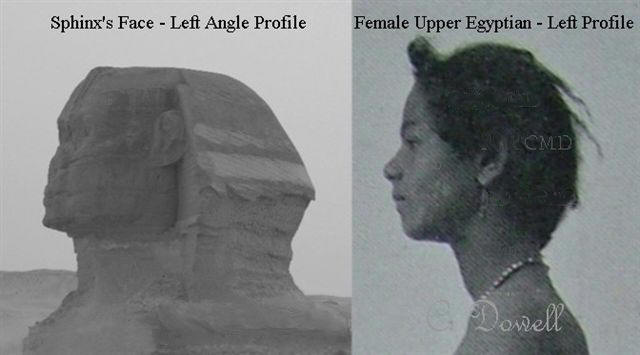
Photograph of Sphinx: RMS
Photograph of Upper Egyptian Female: Stratz -
Graphic of both created by Colette Dowell
The side profile of the Sphinx does not match up with the
side profile of the female Upper Egyptian of the 19th century, the
jaw of the Sphinx is more protruded. But, it makes me wonder why the Sphinx was
sculpted as such revealing a human face with the upper skull removed at the
hairline. Whatever century or dynasty the Sphinx was originally sculpted in is
of interest to me too. If it were carved in retrospect of memorializing and
displaying a Pharaoh or King such as Khafre / Chafre / Chephren,
(all names are of the same individual)
like many people suggest it was, that does not make sense
to me either because many Pharaohs and Kings had elongated skulls and malformed
facial features due to the interbreeding of the royal bloodlines. These
deformations can be found throughout many centuries and dynasties. They also had
dental and jaw malformations. Their facial features were very distorted and in
modern terms many Pharaohs would almost be described as ugly or even creepy
looking, especially with their extreme overbites and jaw malformations. The jaws
of most of the royal bloodlines are extremely protruded as well as early
bloodlines from Middle and South African tribes. (This information is derived
from X-rays of Pharaohs inside their sarcophagi and other studies that have
determined bloodlines of Pharaohs and Kings from facial features and dental
X-rays.)
Photographs of X-rayed Pharaohs from Colette Dowell's private collection.
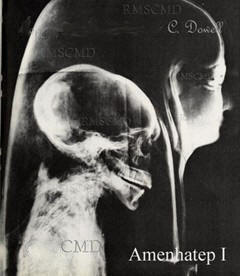 The Pharaohs and Kings did not generally
look like the average or common native of the time because of the inherited
deformations of their skulls. Some malformations were deliberately induced to
signify the difference between royal bloodlines and that of the labor class.
Even in this case scenario, if the Sphinx were sculpted to be that of
King Khafre of the Old Kingdom's Fourth Dynasty, in
approximately 2500 B.C. --why would the Sphinx be
sculpted to have such an average face and not have a more elongated face or
malformed skull and exclude the upper mantle? (Maybe Khafre did have a normal
face, but I suspect not.) Many statues and colossi of the Pharaohs do not match
their skulls that have been X-rayed. The faces on the statues are completely
different then that of the face that would be rectified from the actual skull of
that particular Pharaoh or King. The statues are stylized; they do not depict in
reality the true faces of many of the mummies that have been found of the royal
individuals that hav
The Pharaohs and Kings did not generally
look like the average or common native of the time because of the inherited
deformations of their skulls. Some malformations were deliberately induced to
signify the difference between royal bloodlines and that of the labor class.
Even in this case scenario, if the Sphinx were sculpted to be that of
King Khafre of the Old Kingdom's Fourth Dynasty, in
approximately 2500 B.C. --why would the Sphinx be
sculpted to have such an average face and not have a more elongated face or
malformed skull and exclude the upper mantle? (Maybe Khafre did have a normal
face, but I suspect not.) Many statues and colossi of the Pharaohs do not match
their skulls that have been X-rayed. The faces on the statues are completely
different then that of the face that would be rectified from the actual skull of
that particular Pharaoh or King. The statues are stylized; they do not depict in
reality the true faces of many of the mummies that have been found of the royal
individuals that hav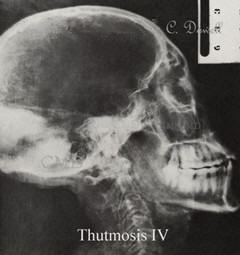 e
been X-rayed.
e
been X-rayed.
This female Upper Egyptian is from the late part of the 19th century. I wonder what a true ancient Upper or Lower Egyptian would look like many millenniums ago, and why is it that the Sphinx is sculpted in the fashion of a proportioned face, but without the upper skull? Also, like the Sphinx, when statues and sculptures of Pharaohs were created there were many versions of faces of the same Pharaoh. Did the Pharaohs want to be sculpted to look more normal and average or did the artists who created the sculptures use their artistic license to design the art suggesting the Pharaohs looked more normal? It is hard to speculate on that issue as we do not have photographs or accurate illustrations of that era in time of the Pharaohs, only little statues and colossal figures or hieroglyphs; all which do not depict the same face in many cases of the same Pharaoh or King --that is why I question the face on the Sphinx. Who is it and what is it?
Could it have been that the Sphinx once had a full head of a human? Could it have been during the time of revolt against the old regime and the new regime during Khafre’s reign that the Sphinx was re-sculpted and the upper skull removed? (Is that why it is attributed to King Khafre?) There are many variations of the Sphinx in different eras from one artist to the next altering the anatomical perspectives. If you look at some miniatures of Sphinxes and little statuettes, their heads are more complete and rounded at the top. Then there are some that are flat on the top as if they were sculpted depicting the flat head of the modern day Great Sphinx; hardly any of them have a protruding lower jaw as many of the Kings and Pharaohs did in real life. But, the jaw of the Great Sphinx protrudes like those of some of the ancient Pharaohs as well as those of certain races of African tribes.
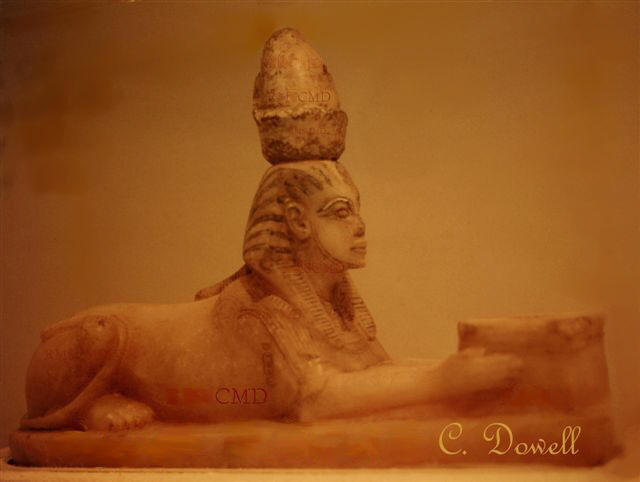
Photograph by: Colette Dowell--Courtesy Luxor Museum, Luxor Egypt
Why is it that the Sphinx’s face straightforward looks
“normal” minus the upper skull mantle and on the side profile the jaw protrudes
like those of the Pharaohs who have been X-rayed and those of some native
individuals? It is all a mystery to me and I am curious about that. There are
many distortions to the face of the Sphinx in the respect to the upper skull and
the jaw line. Is this Great Sphinx depicting a Pharaoh, a King, or an average
African Egyptian of that era? What era was the Great Sphinx completely sculpted
--the whole body and face? Was the face ever really re-sculpted? (In my opinion
I would think the answer to that is yes) And what was the real purpose of the Sphinx --to
memorialize a Pharaoh, a King, or to memorialize the peoples of the nation of
Egypt or what? (The Sphinx also contains many facets to it in relation to its
terrestrial locale, stellar alignments and symbolic myths.) There are many
questions that will probably never be able to be answered. All and all the face
and body of the Sphinx are highly filled with many diverse theories and
speculations; this is just one more treatment to add to the list.
Schwaller de Lubicz had studied Pharaonic Consciousness
and the sacred proportions of the Ancient Egyptians --the way they divided the
body up into sacred mathematical fractions. The particular fraction that is the
most significant in terms of Egyptian Pharaonic Cosmology is the fraction that
represents the upper most mantle of the human skull; 19/18 = consciousness. It
is this fraction, the upper mantle of the skull that is missing from the face of
the Sphinx; I wonder why? If the Sphinx’s face is the original face and it was
originally Egyptian why would the upper mantle of the skull not be properly
fashioned to depict a full skull and facial structure when most all of the other
proportions and features are very closely anatomically correct in every way
depicting a whole human face. Could it be that the Egyptians did not originally
sculpt the Sphinx? Could it be that the face of the Sphinx was re-sculpted and
the upper skull taken off and the face reshaped to memorialize a “new
generation” of civilization: Egyptians? Was the upper skull deliberately removed
as a reminder, or a monumental symbol to show the people they were lacking in
consciousness and needed to develop it? Or was it whacked off in a form of
rebellion during the new regime? If the Sphinx was modeled by the Egyptians and
the face was never re-sculpted, why does it not have a complete skull? If the
Egyptians did not originally model the Sphinx, still why does it not have a
complete skull? And if it was re-sculpted by whomever, why was the upper skull
removed if it originally did have an upper skull intact?
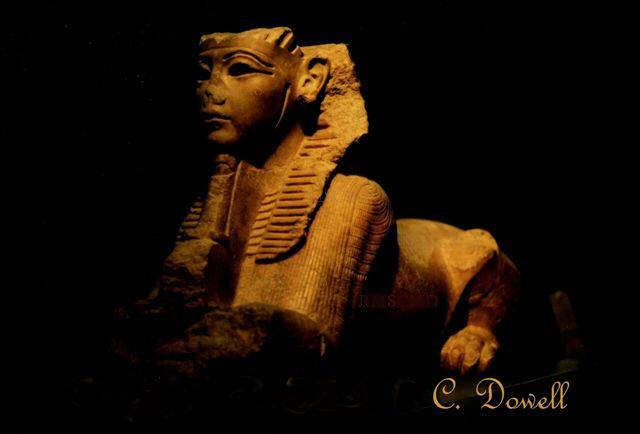
Photograph by Colette Dowell: --Courtesy Luxor Museum, Luxor Egypt
The head of this Sphinx statuette has been broken off.
The argument that there was not a sufficient
amount of stone is inadequate as the face if already disproportionate to the
feline body, so adjusting it to make it a little smaller to incorporate a full
human skull with the divine 19/18 fraction would not have been such a big deal.
But to sculpt the Sphinx’s face without the divine upper mantle of the skull is
somewhat heresy to the Egyptians --unless the Sphinx is an entirely different
model of some other cosmology. However, you will notice on the Sphinx’s
headdress there is an ornament that seats itself over the third eye region of
the Sphinx’s forehead, which could signify consciousness as well, but without
the upper skull it looks out of context and unfinished in symbolique. (That is
my opinion only.) If the Egyptians did not originally sculpt and model the
Sphinx, could it be that the ancients prior to the Egyptians sculpted it, and
they had a flat head?
I doubt that seriously
because there has never been a
human skull found depicting any race of Homo sapiens in evolution that
had a naturally occurring horizontally flat head.
These are only a few questions to ponder, however they are
very intense. I have never heard of any one mentioning the upper skull missing
before on the Sphinx. I noticed it while comparing the photographs. I guess it
has always just been taken for granted that the Sphinx is just how it is,
nothing more. But, to me that does not make sense; to be anatomically correct in
its facial proportions compared to a human in many respects except for its
missing upper skull. If it were truly Egyptian in its origin why would the most
significant human feature of Egyptian Pharaonic Cosmology and sacred proportions
(19 /18 = th e
upper skull mantle of the human body) be missing? Yes, I know, the Sphinx is
part feline and human, but this still does not account for the lack of the
upper skull missing when they incorporated a human
face to represent the face of the Sphinx with its feline body. It does not make
sense. Something is very symbolic about the face on the Sphinx and the
anatomical features that has not yet been distinguished.
e
upper skull mantle of the human body) be missing? Yes, I know, the Sphinx is
part feline and human, but this still does not account for the lack of the
upper skull missing when they incorporated a human
face to represent the face of the Sphinx with its feline body. It does not make
sense. Something is very symbolic about the face on the Sphinx and the
anatomical features that has not yet been distinguished.
In the orthodox view of Egyptology the Egyptians
traditionally began their early formative stages of civilization c. 3000 B.C.
Schwaller de Lubicz’s research was attuned to Egyptian Pharaonic Cosmology, not
that of any other race. So here we might have a possible discrepancy. What race of people
were thriving during that time to build and sculpt the Sphinx? What were their
anatomical facial features like?
NOTE: The upper mantle of the human skull is referenced in Schwaller de Lubicz’s, “THE TEMPLE OF MAN.” Please read The Temple of Man to better understand what I am conveying in regards to the upper mantle of the human skull and its relationship to consciousness. In The Temple of Man you will also read how the Egyptians revered the scarab and defined it as one of their most important neters and symbols in reference to the human skull and consciousness.
Photographs of X-rayed Pharaohs from Colette Dowell's private collection.
![]()
An International Networking Educational Institute
Intellectual, Scientific and Philosophical Studies
Copyright © 1995, 2005, 2006, 2007